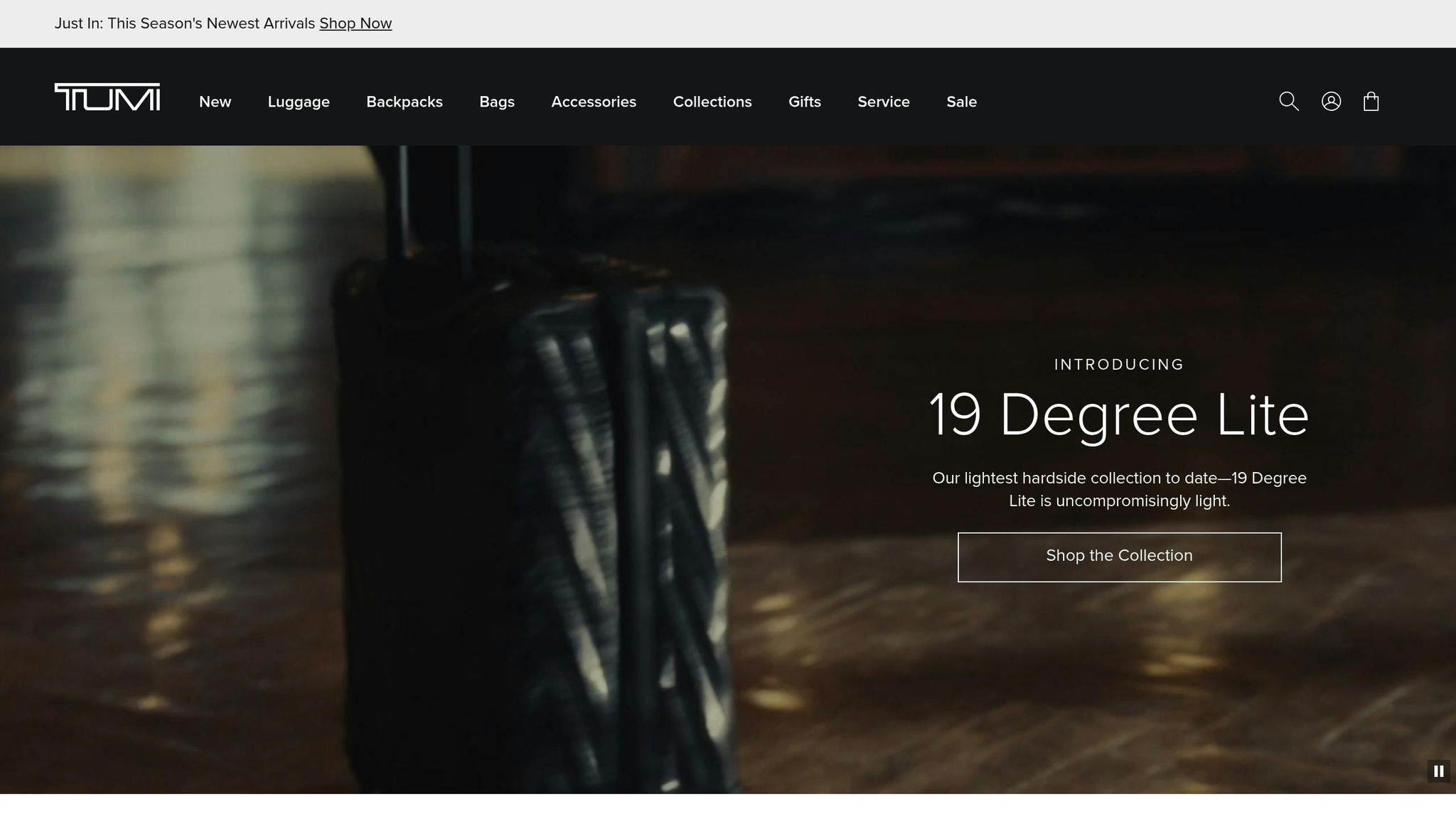Looking for a reliable business bag? Tumi’s premium ballistic nylon bags are known for durability, advanced design, and long lifespans. But are they worth the high price? Budget-friendly brands offer practical, affordable alternatives, but with some trade-offs in material quality, features, and warranties.
Key Takeaways:
- Tumi: High-end bags ($600–$1,000+) with proprietary FXT Ballistic Nylon, lifetime warranties, and advanced organizational features. Best for frequent travelers seeking durability and status.
- Budget Brands: Affordable options ($50–$400) with solid functionality but shorter lifespans, simpler designs, and limited warranties. Ideal for occasional users.
Quick Comparison:
| Feature | Tumi | Budget Brands |
|---|---|---|
| Price Range | $600–$1,000+ | $50–$400 |
| Lifespan | 10–20+ years | 3–8 years |
| Materials | Premium ballistic nylon | Nylon, polyester |
| Warranty | Lifetime | 1–5 years |
| Water Resistance | Superior | Basic coatings |
| Design Features | Advanced organization | Basic compartments |
Tumi excels in quality and longevity, while budget bags focus on affordability. Choose based on how often you travel and your budget.
Ballistic Nylon Material and Benefits
Ballistic Nylon Properties
Ballistic nylon is built for toughness and reliability. Originally created by DuPont during World War II for flak jackets to shield soldiers from shrapnel, this fabric has since transitioned into civilian use, particularly in the business world, thanks to its unmatched durability and strength. Its tightly woven, dense structure is what gives it such remarkable resilience.
The strength of ballistic nylon is measured in denier (D) – a unit that reflects the thickness of the fabric’s threads. Most ballistic nylon fabrics fall between 840D and 1680D. A higher denier count means thicker, sturdier threads, making the material more robust. For example, 1050D ballistic nylon can endure tearing forces of over 26 pounds (12 kgf), and its dense weave offers superior tear resistance compared to other materials.
One standout feature of ballistic nylon is its resistance to abrasion. Its dense weave and high denier construction allow it to handle constant friction and wear without showing much damage. This durability is often tested using standards like ASTM D3884, which evaluates how much wear the fabric can tolerate before breaking down.
Unlike Cordura nylon, which has a textured, rough weave, ballistic nylon features a smooth, tightly packed weave. This design makes it especially effective at resisting tears and punctures, a crucial quality for items like bags that are subjected to daily use and travel.
Ballistic nylon is also water-resistant when treated correctly. Manufacturers often enhance its performance by adding coatings like polyurethane or PVC, which boost water resistance and protect against UV exposure. This makes the material suitable for a variety of weather conditions.
These unique properties explain why ballistic nylon is a go-to material for high-performance bags and gear.
Why Business Professionals Choose This Material
Ballistic nylon’s proven durability translates seamlessly into everyday reliability, making it a favorite among business professionals. It combines rugged functionality with a sleek, polished look, making it suitable for both professional and casual settings.
Laptop bags made from ballistic nylon last 30% longer than those crafted from standard synthetic materials. This extended lifespan means professionals save money over time, as they don’t need to replace their bags as often.
For frequent travelers, abrasion resistance is a game-changer. Ballistic nylon holds up against the wear and tear of airport conveyor belts, overhead compartments, and other travel challenges, all while maintaining its appearance and structural integrity.
Compared to leather, ballistic nylon offers several advantages. It’s more durable, lighter, water-resistant, and requires less upkeep. Plus, it resists scratches and scuffs, ensuring it retains its professional look even after heavy use.
Another factor is cost. While ballistic nylon delivers exceptional performance, it’s more budget-friendly than premium materials like Kevlar.
"Ballistic nylon fabrics are the top-performing choice for any application where strength and abrasion resistance are a top priority." – Mauritzon.net
Some manufacturers are now experimenting with recycled versions of ballistic nylon, aiming to reduce environmental impact. This development appeals to professionals who prioritize sustainability without compromising on quality. It’s a testament to how this material continues to evolve, meeting modern business demands while staying true to its core strengths.
Tumi Business Bags: Premium Features

Tumi Craftsmanship and Materials
Tumi has built its reputation on using top-tier materials combined with meticulous craftsmanship. Designed to withstand the demands of business travel, Tumi bags are crafted with durability and performance in mind.
One standout feature is Tumi’s proprietary FXT Ballistic Nylon. This material blends a unique weave with a specialized coating, creating a bag that’s tough enough to handle daily wear and tear while maintaining a polished look. To ensure their products meet the highest standards, Tumi subjects each bag to a rigorous series of 41 tests – many of which they developed themselves – to guarantee durability and reliability.
Professional Design and Organization
Tumi pairs its durable materials with designs that prioritize functionality and sophistication. Their approach focuses on creating bags that are as practical as they are stylish, tailored specifically for the needs of business professionals.
Features like the TUMI Tracer® make it easier to recover lost bags, adding a layer of convenience and peace of mind. For a personal touch, Tumi offers customization options, including monogramming and accenting services, so users can adapt their bags to reflect their individual professional style. With Tumi, practicality meets elegance in every design.
4 Tips for Buying the BEST Briefcase + Reviews on Tumi, Filson, Shinola Daniel’s NYC’s & more!
sbb-itb-1e6451b
Budget-Friendly Ballistic Nylon Options
After exploring the premium features of Tumi bags, let’s shift focus to more budget-friendly alternatives that still cater to the needs of business travelers.
Features and Benefits of Budget Brands
Budget ballistic nylon bags strike a balance between durability and affordability. Priced between $50 and $400, they appeal to a broader audience compared to high-end options.
These bags prioritize essential functionality for business travelers. Common features include padded laptop compartments (accommodating devices up to 16 inches), multiple pockets for organizing documents and accessories, and adjustable straps for added comfort. While some use genuine ballistic nylon, others rely on high-quality alternatives like Cordura nylon, which offers similar tear resistance with a lighter feel.
For example, the Aer Go Pack 2 ($99, released February 2025) utilizes 210D Cordura® crinkle nylon and includes a suspended 16-inch laptop pocket, interior zippered compartments, and multiple exterior pockets. Similarly, the Aer City Pack ($149) boasts a 1680D Cordura® ballistic nylon exterior, dual compartments, and practical organizational features.
Budget brands excel in straightforward organization without unnecessary frills. The Osprey Aoede Briefpack ($150) offers versatile carrying options with stowable backpack straps, a removable shoulder strap, and a briefcase-style handle. Meanwhile, the EVERGOODS Panel Loader Classic 20L ($149) focuses on durability and easy access with its panel-loading design.
Modern business needs are also addressed. The Incase ICON Lite Pack ($99.99) features a faux-fur-lined laptop sleeve for extra protection, while the Bellroy Via Backpack ($129) includes water-resistant zippers and a drop-down front panel for quick access to essentials.
While these options deliver on core features, they come with certain compromises.
Trade-Offs in Budget Options
Budget bags, while practical and affordable, do involve some sacrifices. One of the most noticeable trade-offs is in material quality and construction. To keep costs down, many budget brands use lower denier nylon or polyester blends, which can result in thinner fabrics that may wear down faster under heavy use.
Finish quality is another area where budget options fall short. Premium bags often feature reinforced stitching, high-grade hardware, and luxurious internal linings. In contrast, budget alternatives typically rely on standard components that, while functional, may not hold up as well over time. Zippers, buckles, and handles on these bags often lack the smooth operation and durability seen in high-end models.
Warranty support also varies significantly. Premium brands like Tumi offer extensive warranties and repair services, whereas most budget options provide limited coverage – typically one to three years. This shorter warranty period often means replacing the bag sooner, but the lower upfront cost can make this trade-off acceptable.
Water resistance is another area where budget bags may fall short. Polyester, commonly used in these products, is less water-repellent than premium ballistic nylon. While many budget options include water-resistant coatings, they may not perform as effectively in heavy rain or humid conditions.
Lastly, organizational systems in budget bags tend to be simpler. While premium bags often include advanced features like RFID-blocking compartments and highly specialized storage layouts, budget alternatives usually stick to the basics: a padded laptop sleeve, a spacious main compartment, and a few general-purpose pockets. Security features, too, are more basic, often limited to TSA locks and durable zippers.
Despite these compromises, budget-friendly ballistic nylon bags can meet the needs of many business travelers. The key is identifying which features matter most to you and choosing a bag that aligns with your travel habits and durability expectations.
Tumi vs Budget Brands: Side-by-Side Comparison
Here’s a breakdown of how Tumi compares to budget brands on features that matter most to business professionals.
Feature and Price Comparison Table
| Feature | Tumi | Budget Brands |
|---|---|---|
| Price Range | $600-$1,000+ for carry-ons | $50-$400 for most models |
| Primary Materials | Ballistic nylon, aluminum, premium polycarbonate | Polyester, ABS plastic, standard nylon |
| Expected Lifespan | 10-20 years or lifetime | 3-8 years depending on material |
| Warranty Coverage | Lifetime warranty and repair services | 1-5 years, limited repair options |
| Water Resistance | Superior with ballistic nylon | Basic coatings; less effective in heavy rain |
| Organizational Features | Sophisticated internal systems, 125+ patents | Basic compartments and pockets |
| Testing Standards | 41 unique durability tests | Standard industry testing |
| Brand Status | Recognized luxury symbol | Functional; no prestige factor |
While Tumi bags come with a higher price tag, their durability, superior materials, and lifetime warranty can make them more cost-effective in the long run. For example, an $800 Tumi bag that lasts 15 years costs about $53 per year, compared to a $150 budget bag that lasts 4 years, averaging $38 per year. Budget bags may seem cheaper upfront, but frequent replacements can add up over time.
When to Choose Each Option
Your decision ultimately depends on your travel habits and budget. Here’s how to decide.
Choose Tumi if you travel frequently and prioritize durability, organization, and status. For frequent flyers, the premium materials, advanced organizational features, and lifetime warranty make Tumi a worthwhile investment. Travel + Leisure‘s 2025 testing highlighted the Tumi Alpha International Expandable 4-wheeled Carry-on, noting its compact design, multiple compartments, and even a removable garment bag.
Opt for budget brands if you travel occasionally and prefer lower upfront costs. Budget options deliver solid performance for infrequent use, making them a practical choice if your travel needs don’t justify the expense of a premium bag.
Match your choice to your travel patterns. Frequent business travelers who often check luggage may benefit more from Tumi’s durability, while those sticking to carry-ons might find budget options sufficient. By aligning your choice with your travel habits, you can make an informed investment that fits your needs.
Conclusion
The comparison above lays out the major distinctions between premium and budget ballistic nylon options. Ultimately, the right choice comes down to how often you travel, your budget, and what matters most to you in a travel bag.
Tumi stands out with its high-quality materials, sleek design, and attention to detail, which many frequent travelers find worth the $600–$1,000+ price tag. However, some users have noted issues with zippers and handles over time. For those who value durability and a touch of prestige, Tumi remains a popular choice.
On the other hand, budget-friendly options prioritize practicality and affordability. They’re ideal for occasional travelers, though they may need replacing more often.
The best bag for you is the one that fits your travel habits and strikes the right balance between upfront cost and how long it will last.
FAQs
What should I consider when deciding between Tumi bags and more affordable ballistic nylon options for business travel?
When deciding between Tumi bags and more affordable ballistic nylon options for business travel, it often comes down to durability, material quality, and design. Tumi bags stand out for their high-end ballistic nylon construction, which not only ensures impressive longevity but also delivers a polished, professional look. That said, their premium price tag might not fit everyone’s budget or travel priorities.
Meanwhile, budget-friendly ballistic nylon bags can still offer solid durability, practical compartments, and essential features for business trips. However, they may not hold up as long or offer the same level of sophistication in design. Think about how frequently you travel, how much you value a sleek appearance, and your budget to figure out which option works best for you.
How does Tumi’s FXT Ballistic Nylon compare to budget-friendly ballistic nylon in terms of durability and lifespan?
Tumi’s FXT Ballistic Nylon is built to last, thanks to its specialized weave and coating that provide extra protection against tears, abrasions, and the wear and tear of daily use. This makes it a favorite among professionals who need a bag that can handle constant, heavy-duty use.
While more affordable ballistic nylon options do offer decent durability and resistance to abrasions, they often fall short when it comes to the reinforced strength and longevity of Tumi’s FXT material. For those seeking a dependable, long-term solution for demanding business needs, Tumi’s FXT Ballistic Nylon is a standout choice.
When might a budget-friendly ballistic nylon bag be a better choice than a Tumi bag?
A ballistic nylon bag is a smart pick for those who need something tough and affordable. Whether you’re a frequent traveler, an outdoor adventurer, or someone who simply puts their bag through a lot of wear and tear, this material is built to last.
These bags are also a great option if you’re looking for something lightweight but sturdy enough for daily use. Whether you’re commuting to work, heading out on a hike, or navigating unpredictable travel conditions, a ballistic nylon bag gets the job done. If durability and budget-friendliness are what you’re after, this type of bag delivers both without skimping on functionality.




 Mobile/What's App/Wechat
Mobile/What's App/Wechat E-Mail
E-Mail ADD
ADD




